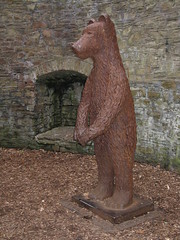 We took a stroll around Sheffield's Botanical Gardens yesterday, making the most of a swift return to unseasonably warm weather. Tucked away in the gardens is one of Sheffield's historical curiosities: a bear pit.
We took a stroll around Sheffield's Botanical Gardens yesterday, making the most of a swift return to unseasonably warm weather. Tucked away in the gardens is one of Sheffield's historical curiosities: a bear pit.This Grade II listed structure dates from 1836 and housed two bears until the 1870s. According to an information board at the site, there is a local legend that the removal of the bears occurred after a child fell into the pit and was killed; however the official website recounts this story as historical fact: you will have to make up your own mind as to whether to believe the tale.
There are two small dens on either side of the main entrance to the pit which originally housed the bears. The first thing that struck me about these was that they are incredibly small: I can imagine that a large bear would become very irritable very quickly in such a small space, but sadly I suspect that was probably the intention. There are large metal grilles at the entrance that can be pulled across and locked to keep the occupants inside; these were re-instated during the restoration of the pit.
 The pit itself is around 8 or 9 metres across (large enough to be seen on Google Earth - see below), and is topped off with elegant new railings that helpfully prevent you from falling in and being eaten by bears...
The pit itself is around 8 or 9 metres across (large enough to be seen on Google Earth - see below), and is topped off with elegant new railings that helpfully prevent you from falling in and being eaten by bears...The beautifully restored modern day version of the bear pit also contains a rather splendid bear. David Mayne's 2005 "Bear" sculpture looks fantastic in this perfect setting. It is life sized, standing at around 2m high. The bear looks pretty friendly standing on his back paws with his front legs dangling down at his sides (and of course with just one bear, no fights can break out). The sculpture is made from mild steel with a rusted finish that is perfect for a brown bear's pelt.
Children (and adults) can find a clue from the riddle trail written around the base of the sculpture. The riddle is one of a series, written by well known local author Berlie Doherty, to encourage people to explore the gardens.
I'll certainly be exploring further in the not too distant future.
View Larger Map
N.B. The aerial images on Google were taken during the period when the Botanical Gardens were undergoing major restoration work.
--Originally published here on my main blog http://three-legged-cat.blogspot.com/
Comments on the original post
